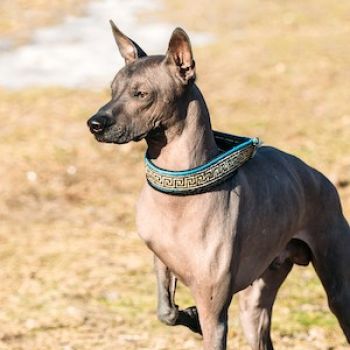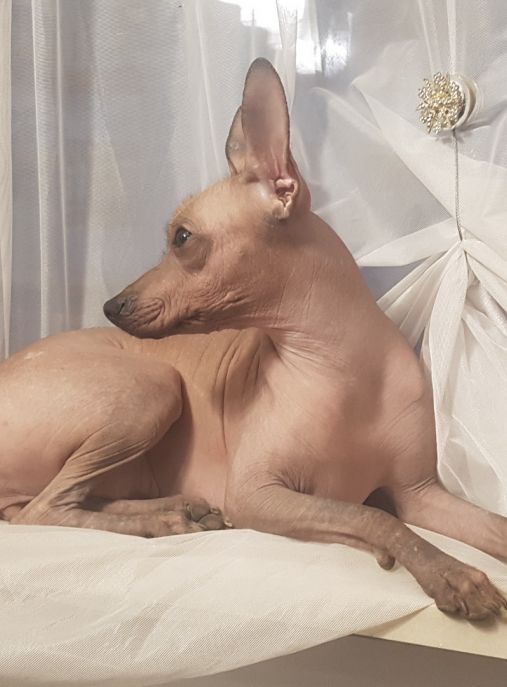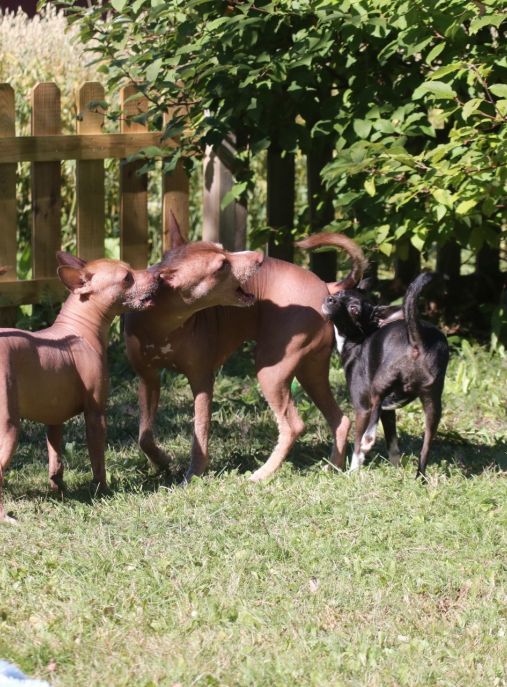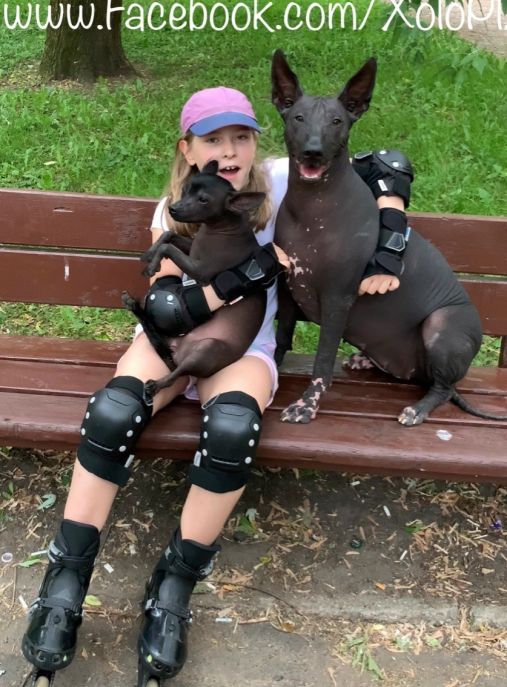The Xoloitzcuintle Intermediate, also known as the Mexican Hairless Dog, is a unique and fascinating breed that has captivated dog enthusiasts around the world. With its ancient origins and distinctive appearance, this breed has a rich history and a special place in the hearts of many dog lovers.
The Xoloitzcuintle Intermediate is a medium-sized dog that falls under the category of primitive breeds. It is one of three varieties of the Xoloitzcuintle breed, the others being the Toy and Standard varieties. This particular variety is considered to be the middle ground in terms of size, making it an ideal choice for those who desire a dog that is not too small or too large.
The history of the Xoloitzcuintle breed dates back thousands of years to pre-Columbian times in Mexico. These dogs were highly revered by the ancient Aztecs and Mayans, who believed that they possessed mystical and healing powers. They were often depicted in ancient artwork and were even considered sacred companions to the gods.
According to the FCI (Fédération Cynologique Internationale) typology, the Xoloitzcuintle Intermediate belongs to Group 5, which includes the Spitz and Primitive types of dogs. This group consists of breeds that have retained their primitive characteristics and exhibit traits that are closer to their wild ancestors.
The Xoloitzcuintle Intermediate is a versatile breed that can serve various purposes. While they make excellent family pets, they are also well-suited for activities such as agility, obedience, and even therapy work. Their calm and gentle nature, combined with their intelligence and loyalty, make them wonderful companions for individuals or families of all ages.
In terms of physical characteristics, the Xoloitzcuintle Intermediate typically weighs between 20 to 30 pounds (9 to 14 kilograms) and stands at a height of around 16 to 20 inches (41 to 51 centimeters) at the shoulder. Their bodies are well-muscled and athletic, with a graceful and elegant appearance. One of the most distinguishing features of this breed is its hairless coat, although a coated variety does exist as well. The skin of the hairless variety is smooth and soft, while the coated variety has a short, dense, and sleek coat.
The Xoloitzcuintle Intermediate has a life expectancy of around 12 to 15 years, which is relatively long compared to some other breeds of similar size. They are generally healthy dogs with few breed-specific health issues. However, like all dogs, they require regular veterinary care, a balanced diet, and plenty of exercise to maintain their overall well-being.
Despite their hairless appearance, Xoloitzcuintles are not hypoallergenic. While they may produce fewer allergens than some other breeds, they can still cause allergies in sensitive individuals. Regular grooming is essential for the hairless variety to keep their skin healthy and protected from the sun. Coated Xoloitzcuintles require minimal grooming, with occasional brushing to maintain their coat's condition.
One interesting fact about the Xoloitzcuintle Intermediate is its association with the Day of the Dead, a Mexican holiday that celebrates and honors deceased loved ones. It is believed that these dogs have a spiritual connection to the afterlife and are often included in the festivities. They are adorned with colorful decorations and are believed to guide the souls of the departed.
In conclusion, the Xoloitzcuintle Intermediate is a remarkable breed with a rich history and unique characteristics. From its ancient origins to its versatile nature, this breed has captured the hearts of many dog enthusiasts. Whether as a loyal companion or a working dog, the Xoloitzcuintle Intermediate continues to leave a lasting impression on those who have the pleasure of knowing and appreciating this extraordinary breed.
The Xoloitzcuintle Intermediate, also known as the Mexican Hairless Dog, is a unique and fascinating breed with a rich history. These dogs possess a distinct character that sets them apart from other breeds. With their loyal and affectionate nature, they make excellent companions for those who appreciate their special qualities.
One of the most notable characteristics of Xoloitzcuintle Intermediate dogs is their calm and gentle demeanor. They are known for being incredibly patient and tolerant, making them great family pets. These dogs are highly adaptable and can easily adjust to different living environments, whether it be a bustling city apartment or a quiet countryside home.
Despite their calm nature, Xoloitzcuintle Intermediates are also known to be alert and protective. They have a strong sense of loyalty towards their family and will go to great lengths to protect them if they sense any danger. This makes them excellent watchdogs, as they are quick to alert their owners of any potential threats.
When it comes to training, Xoloitzcuintle Intermediates are intelligent and eager to please. They are quick learners and respond well to positive reinforcement techniques. However, it is important to note that they can be sensitive to harsh training methods, so a gentle and patient approach is essential. Consistency and firmness in training will help establish boundaries and ensure a well-behaved dog.
Socialization is crucial for Xoloitzcuintle Intermediates from an early age. Exposing them to various people, animals, and environments will help them develop into well-rounded dogs. They generally get along well with other pets, especially if they are introduced gradually and positively. However, it is important to supervise their interactions, as some Xoloitzcuintle Intermediates may display dominant behavior towards unfamiliar dogs.
Exercise is essential for the physical and mental well-being of Xoloitzcuintle Intermediates. While they are not excessively energetic, they still require regular walks and playtime to prevent boredom and maintain a healthy weight. Mental stimulation, such as puzzle toys or obedience training, can also help keep their minds sharp and prevent destructive behaviors.
Grooming Xoloitzcuintle Intermediates is relatively easy due to their hairless or short-haired coats. Hairless Xolos require regular skincare to protect their sensitive skin from sunburn and dryness. Applying sunscreen and moisturizers specifically designed for dogs is recommended. Additionally, regular dental care, nail trimming, and ear cleaning are essential parts of their grooming routine.
Xoloitzcuintle Intermediates thrive on human companionship and are known to form strong bonds with their owners. They are affectionate and enjoy being close to their loved ones. However, they can also be independent at times and may appreciate having their own space to retreat to when needed.
In conclusion, Xoloitzcuintle Intermediate dogs possess a unique character that combines loyalty, gentleness, and protectiveness. They are intelligent and trainable, making them suitable for various lifestyles. With proper socialization, training, and care, these dogs can become loving and well-behaved companions for individuals or families who appreciate their special qualities.
The Xoloitzcuintle, also known as the Mexican Hairless Dog, is a unique and ancient breed that requires specific care to ensure their well-being. As an intermediate-sized dog, they have distinct characteristics and needs that should be considered when providing them with the best care possible. Here are some tips on how to care for Xoloitzcuintle Intermediate dogs, including what to do and what not to do:
1. Grooming: Xoloitzcuintles have little to no hair, but they still require regular grooming. Their skin is sensitive and prone to sunburn, so apply sunscreen or provide shade when they are exposed to the sun. Regularly check their skin for any irritations or infections and keep it clean and moisturized. Bathing should be done occasionally using a mild shampoo suitable for their sensitive skin.
2. Exercise: Xoloitzcuintles are an active breed and require regular exercise to maintain their physical and mental well-being. Daily walks, playtime, and interactive toys are essential to keep them stimulated. However, be cautious not to overexert them, especially during hot weather, as they are more susceptible to heatstroke due to their lack of hair.
3. Nutrition: Provide a balanced and nutritious diet suitable for your Xoloitzcuintle's age, size, and activity level. Consult with a veterinarian to determine the appropriate portion sizes and feeding schedule. Avoid overfeeding, as Xoloitzcuintles are prone to weight gain, which can lead to various health issues.
4. Socialization: Xoloitzcuintles are known for their loyalty and affection towards their family. However, they can be reserved or wary of strangers. Early socialization is crucial to ensure they are comfortable around new people, animals, and different environments. Expose them to various situations, including different sounds, sights, and experiences, to help them become well-rounded and confident dogs.
5. Training: Xoloitzcuintles are intelligent and eager to please, making them relatively easy to train. Use positive reinforcement techniques such as treats, praise, and play to motivate and reward good behavior. Consistency, patience, and firm but gentle guidance are key to successful training. Avoid harsh training methods or punishment, as it can lead to fear or aggression in this sensitive breed.
6. Health care: Regular veterinary check-ups are essential to monitor your Xoloitzcuintle's overall health and address any potential issues promptly. Vaccinations, parasite prevention, dental care, and routine blood work should be part of their healthcare regimen. Additionally, Xoloitzcuintles are prone to dental problems, so regular teeth brushing is crucial to maintain good oral hygiene.
7. Temperature regulation: Due to their lack of hair, Xoloitzcuintles are more sensitive to extreme temperatures. Provide them with appropriate shelter and bedding to keep them warm during colder months. In hot weather, ensure they have access to shade, fresh water, and avoid prolonged exposure to direct sunlight.
What not to do:
1. Do not leave your Xoloitzcuintle alone for extended periods. They thrive on human companionship and can become anxious or develop separation anxiety if left alone for too long.
2. Do not neglect their dental care. Poor oral hygiene can lead to dental diseases and discomfort for your Xoloitzcuintle.
3. Do not force your Xoloitzcuintle into uncomfortable situations or overwhelm them with too many new experiences at once. Gradual exposure and positive reinforcement are key to successful socialization.
4. Do not overfeed your Xoloitzcuintle. Obesity can lead to various health issues, including joint problems and decreased lifespan.
5. Do not expose your Xoloitzcuintle to extreme temperatures without proper protection. They are more susceptible to heatstroke and sunburn, so take necessary precautions.
Remember, each Xoloitzcuintle is unique, and their care may vary slightly. Always consult with a veterinarian or a professional Xoloitzcuintle breeder for personalized advice and guidance on the specific needs of your dog.
The Xoloitzcuintle Intermediate, also known as the Mexican Hairless Dog, is a unique and ancient breed that possesses a wide range of colors. However, the most common color seen in these dogs is a striking shade of gray.
The gray color of the Xoloitzcuintle Intermediate is often described as a beautiful and elegant hue that ranges from a light silver to a deep charcoal. This color is typically seen in various patterns and shades, adding depth and character to the dog's appearance.
The coat of the Xoloitzcuintle Intermediate is smooth and sleek, accentuating the gray color and giving it a lustrous sheen. The texture of the coat is soft to the touch, making it a delight to stroke and pet. The gray color is evenly distributed throughout the body, giving the dog a balanced and harmonious appearance.
One of the fascinating aspects of the gray color in Xoloitzcuintle Intermediates is its ability to change in different lighting conditions. Under natural sunlight, the gray coat can appear vibrant and radiant, reflecting the surrounding environment. In dimmer lighting, the gray color may appear more subdued, creating an air of mystery and elegance.
The gray color of the Xoloitzcuintle Intermediate is often complemented by other markings and patterns. It is not uncommon to see dogs with darker gray spots or patches scattered across their bodies, adding a touch of uniqueness and individuality. These markings can vary in size and shape, creating a visually appealing contrast against the overall gray color.
Another notable feature of the gray color in Xoloitzcuintle Intermediates is its ability to highlight the dog's physical features. The color can accentuate the dog's muscular build, showcasing its strength and agility. It can also emphasize the dog's facial expressions, making its eyes and facial structure more prominent and captivating.
Overall, the gray color of the Xoloitzcuintle Intermediate is a captivating and versatile shade that enhances the breed's distinctive appearance. It is a color that exudes elegance, grace, and sophistication, making these dogs truly stand out in any setting. Whether in motion or at rest, the gray coat of the Xoloitzcuintle Intermediate is a testament to the breed's beauty and allure.
The Xoloitzcuintle Intermediate, also known as the Mexican Hairless Dog, is a unique and ancient breed with a fascinating history. These dogs have been revered for their distinctive appearance and loyal nature for centuries. When it comes to their health, Xoloitzcuintle Intermediates are generally a robust and healthy breed. However, like any other dog, they are prone to certain health conditions that owners should be aware of to ensure their well-being.
One of the most common health issues seen in Xoloitzcuintle Intermediates is dental problems. Due to their lack of hair, these dogs often have fewer teeth than other breeds, and their remaining teeth can be more susceptible to decay and gum disease. Regular dental care, including brushing their teeth and providing dental chews, is crucial to maintain their oral health.
Another common health concern in Xoloitzcuintle Intermediates is skin-related issues. Their hairless coat makes them more prone to sunburn, dryness, and skin infections. It is essential to protect their skin from excessive sun exposure by applying pet-safe sunscreen and providing shade when outdoors. Regular moisturizing with hypoallergenic lotions or oils can help prevent dryness and maintain healthy skin.
Additionally, Xoloitzcuintle Intermediates are prone to certain genetic conditions. One such condition is hip dysplasia, a degenerative joint disease that affects the hip joints. Regular exercise, a balanced diet, and maintaining a healthy weight can help reduce the risk and severity of hip dysplasia. Regular veterinary check-ups are essential to detect and manage this condition early on.
Another genetic condition seen in Xoloitzcuintle Intermediates is progressive retinal atrophy (PRA). PRA is a degenerative eye disease that leads to vision loss and, in severe cases, blindness. Regular eye examinations by a veterinary ophthalmologist can help detect PRA early, allowing for appropriate management and support.
To ensure the overall health and well-being of Xoloitzcuintle Intermediates, proper nutrition is vital. A high-quality, balanced diet that meets their specific nutritional needs is essential. Consultation with a veterinarian can help determine the best diet for your Xoloitzcuintle Intermediate, taking into consideration their age, activity level, and any specific health concerns.
Regular exercise is also crucial for maintaining the health of Xoloitzcuintle Intermediates. These dogs are energetic and require daily physical activity to prevent obesity and keep their muscles toned. Engaging in activities such as walks, runs, and interactive play sessions will not only keep them physically fit but also mentally stimulated.
Lastly, routine veterinary care is essential for the health of Xoloitzcuintle Intermediates. Regular vaccinations, parasite prevention, and annual check-ups are necessary to detect any potential health issues early on. Additionally, spaying or neutering your Xoloitzcuintle Intermediate can help prevent certain reproductive health problems and reduce the risk of certain cancers.
In conclusion, Xoloitzcuintle Intermediates are generally a healthy breed, but they are prone to specific health conditions that owners should be aware of. Dental problems, skin-related issues, hip dysplasia, and progressive retinal atrophy are some of the common health concerns in this breed. Providing proper dental care, protecting their skin, maintaining a balanced diet, regular exercise, and routine veterinary care are essential for ensuring the overall health and well-being of Xoloitzcuintle Intermediate dogs.
The Xoloitzcuintle, also known as the Mexican Hairless Dog, is a unique and ancient breed that requires specific attention to their nutrition to ensure their overall health and well-being. As an intermediate-sized dog, their dietary needs may differ slightly from other breeds. In this text, we will provide an extensive description of the nutrition requirements for Xoloitzcuintle Intermediate dogs, along with advice on how to feed them and what to avoid.
First and foremost, it is essential to provide a balanced and nutritious diet for your Xoloitzcuintle Intermediate. This breed is generally known for being healthy and robust, but a well-rounded diet is crucial to support their unique characteristics. A high-quality commercial dog food that is specifically formulated for intermediate-sized dogs is a good starting point. Look for a brand that uses real meat as the primary ingredient and avoids artificial additives or fillers.
Protein is a vital component of a Xoloitzcuintle Intermediate's diet. It helps in muscle development and maintenance, as well as supporting a healthy immune system. Ensure that the dog food you choose contains a good source of animal protein, such as chicken, beef, or fish. Aim for a protein content of around 20-25% in their diet.
In addition to protein, Xoloitzcuintle Intermediates require a moderate amount of healthy fats. Fats provide energy, aid in nutrient absorption, and promote a shiny coat and healthy skin. Look for dog foods that include sources of omega-3 and omega-6 fatty acids, such as fish oil or flaxseed oil. These fatty acids also have anti-inflammatory properties, which can benefit dogs with skin allergies or joint issues.
Carbohydrates are another essential component of a Xoloitzcuintle Intermediate's diet. However, it is important to choose complex carbohydrates that provide sustained energy rather than simple sugars. Whole grains like brown rice, oats, and quinoa are excellent choices. Avoid dog foods that contain excessive amounts of corn, wheat, or soy, as these ingredients can cause allergies or digestive issues in some dogs.
Feeding guidelines for Xoloitzcuintle Intermediates may vary depending on their age, weight, and activity level. It is best to consult with your veterinarian to determine the appropriate portion sizes and feeding frequency for your specific dog. Generally, dividing their daily food intake into two meals is recommended to prevent overeating and aid digestion.
While providing a balanced diet is crucial, it is equally important to avoid certain foods that can be harmful to Xoloitzcuintle Intermediates. Some common foods that should be avoided include chocolate, caffeine, grapes, raisins, onions, garlic, and avocados. These foods can be toxic to dogs and may cause severe health issues or even be fatal.
Additionally, be cautious about overfeeding your Xoloitzcuintle Intermediate, as they have a tendency to gain weight if not properly monitored. Obesity can lead to various health problems, including joint issues and heart disease. Regular exercise, portion control, and avoiding excessive treats are essential to maintaining a healthy weight for your dog.
In conclusion, providing a balanced and nutritious diet is crucial for the overall health and well-being of Xoloitzcuintle Intermediate dogs. Choose a high-quality dog food that contains real meat as the primary ingredient, along with complex carbohydrates and healthy fats. Avoid foods that are toxic to dogs and be mindful of portion sizes to prevent obesity. By following these guidelines and consulting with your veterinarian, you can ensure that your Xoloitzcuintle Intermediate receives the nutrition they need to thrive.








